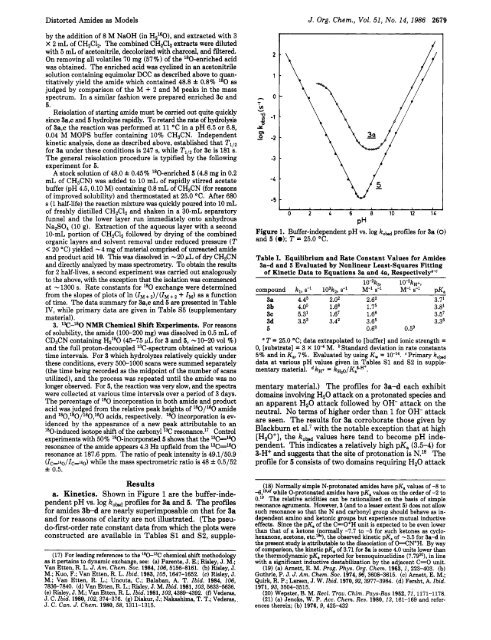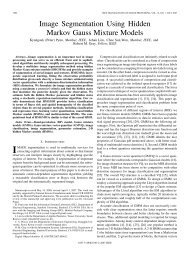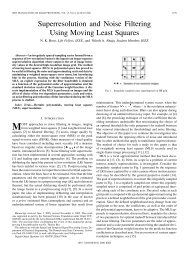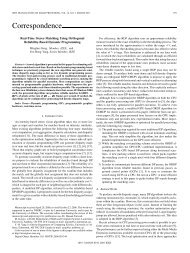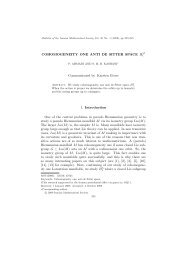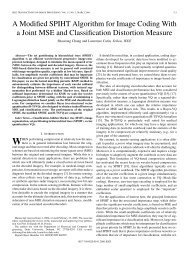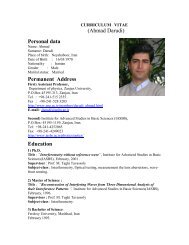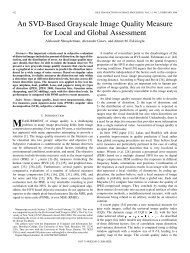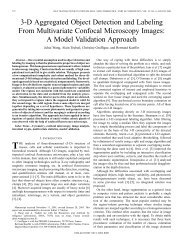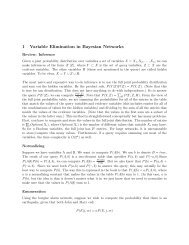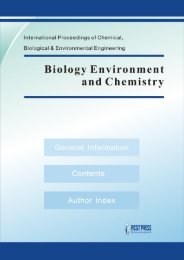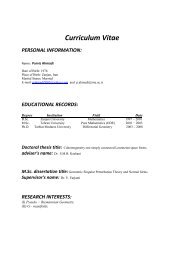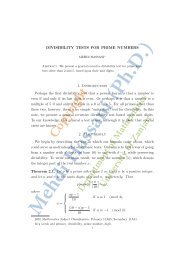Org. Chem. 1986,51, 2676
Org. Chem. 1986,51, 2676
Org. Chem. 1986,51, 2676
Create successful ePaper yourself
Turn your PDF publications into a flip-book with our unique Google optimized e-Paper software.
Distorted Amides as Models J. <strong>Org</strong>. <strong>Chem</strong>., Vol. <strong>51</strong>, No. 14, <strong>1986</strong> 2679<br />
by the addition of 8 M NaOH (in Hz160), and extracted with 3<br />
x 2 mL of CHZCl2. The combined CHzClz extracts were diluted<br />
with 5 mL of acetonitrile, decolorized with charcoal, and fiitered.<br />
On removing all volatiles 70 mg (57%) of the 180-enriched acid<br />
was obtained. The enriched acid was cyclized in an acetonitrile<br />
solution containing equimolar DCC as described above to quantitatively<br />
yield the amide which contained 48.8 f 0.8% "0 as<br />
judged by comparison of the M + 2 and M peaks in the mass<br />
spectrum. In a similar fashion were prepared enriched 3c and<br />
5.<br />
Reisolation of starting amide must be carried out quite quickly<br />
since 3a,c and 5 hydrolyze rapidly. To retard the rate of hydrolysis<br />
of 3a,c the reaction was performed at 11 OC in a pH 6.5 or 6.8,<br />
0.04 M MOPS buffer containing 10% CH3CN. Independent<br />
kinetic analysis, done as described above, established that T1p<br />
for 3a under these conditions is 247 s, while T1 for 3c is 181 s.<br />
The general reisolation procedure is typified by the following<br />
experiment for 5.<br />
A stock solution of 48.0 f 0.45% lS0-enriched 5 (4.8 mg in 0.2<br />
mL of CH3CN) was added to 10 mL of rapidly stirred acetate<br />
buffer (pH 4.5,O.lO M) containing 0.8 mL of CH3CN (for reasons<br />
of improved solubility) and thermostated at 25.0 "C. After 680<br />
s (1 half-life) the reaction mixture was quickly poured into 10 mL<br />
of freshly distilled CH2C12 and shaken in a 30-mL separatory<br />
funnel and the lower layer run immediately onto anhydrous<br />
Na2S04 (10 g). Extraction of the aqueous layer with a second<br />
10-mL portion of CHzClz followed by drying of the combined<br />
organic layers and solvent removal under reduced pressure (T<br />
< 20 "C) yielded -4 mg of material comprised of unreacted amide<br />
and product acid 10. This was dissolved in -20 WL of dry CH3CN<br />
and directly analyzed by mass spectrometry. To obtain the results<br />
for 2 half-lives, a second experiment was carried out analogously<br />
to the above, with the exception that the isolation was commenced<br />
at - 1300 s. Rate constants for lSO exchange were determined<br />
from the slopes of plots of In (IM + 2) / (IM + 2 + IM) as a function<br />
of time. The data summary for 3a,c and 5 are presented in Table<br />
IV, while primary data are given in Table S5 (supplementary<br />
material).<br />
3. l%-lsO NMR <strong>Chem</strong>ical Shift Experiments. For reasons<br />
of solubility, the amide (100-200 mg) was dissolved in 0.5 mL of<br />
CD3CN containing H2180 (45-75 WL for 3 and 5, -10-20 vol %)<br />
and the full proton-decoupled 13C-spectrum obtained at various<br />
time intervals. For 3 which hydrolyzes relatively quickly under<br />
these conditions, every 500-1000 scans were summed separately<br />
(the time being recorded as the midpoint of the number of scans<br />
utilized), and the process was repeated until the amide was no<br />
longer observed. For 5, the reaction was very slow, and the spectra<br />
were collected at various time intervals over a period of 3 days.<br />
The percentage of l80 incorporation in both amide and product<br />
acid was judged from the relative peak heights of 1sO/160 amide<br />
and '80,'80/180,1e0 acids, respectively. l80 incorporation is evidenced<br />
by the appearance of a new peak attributable to an<br />
180-induced isotope shift of the carbonyl 13C resonance." Control<br />
experiments with 50% lsO-incorporated 5 shows that the 13C=1s0<br />
resonance of the amide appears 4.3 Hz upfield from the 13C=160<br />
resonance at 187.6 ppm. The ratio of peak intensity is 49.1/50.9<br />
(Ic=ieo/Ic=iy,) while the mass spectrometric ratio is 48 f 05/52<br />
* 0.5.<br />
Results<br />
a. Kinetics. Shown in Figure 1 are the buffer-inde-<br />
pendent pH vs. log kom profiles for 3a and 5. The profiles<br />
for amides 3b-d are nearly superimposable on that for 3a<br />
and for reasons of clarity are not illustrated. (The pseu-<br />
do-fiist-order rate constant data from which the plots were<br />
constructed are available in Tables S1 and S2, supple-<br />
(17) For leading references to the 1s0-'3C chemical shift methodology<br />
as it pertains to dynamic exchange, see: (a) Parente, J. E.; Risley, J. M.;<br />
Van Etten, R. L. J. Am. <strong>Chem</strong>. SOC. 1984,106,<strong>51</strong>56-8161. (b) Risley, J.<br />
M.; Kuo, F.; Van Etten, R. L. Ibid. 1983,105,1647-1652. (c) Risley, J.<br />
M.; Van Etten, R. L.; Uncuta, C.; Balaban, A. T. Ibid. 1984, 106,<br />
7836-7840. (d) Van Etten, R. L.; Risley, J. M. Ibid. 1981,103,5633-5636.<br />
(e) Risley, J. M.; Van Etten, R. L. Ibid. 1981,103,4389-4392. (0 Vederas,<br />
J. C. Ibid. 1980,102,374-376. (9) Diakur, J.; Nakashima, T. T.; Vederas,<br />
J. C. Can. J. <strong>Chem</strong>. 1980,58, 1311-1315.<br />
-<br />
2<br />
- 0<br />
cn<br />
1<br />
-. 1 -1<br />
Y<br />
0 -2<br />
-3<br />
-4<br />
-5<br />
0 2 4 6 8 1 0 1 2 1 4<br />
PH<br />
Figure 1. Buffer-independent pH vs. log kow profiles for 3a (0)<br />
and 5 (0); T = 25.0 OC.<br />
Table I. Equilibrium and Rate Constant Values for Amides<br />
3a-d and 5 Evaluated by Nonlinear Least-Squares Fitting<br />
of Kinetic Data to Equations 3a and 4a, Respectively"*<br />
10-2k3, 10-'kH+,<br />
compound k,, s-l 103k2, s-l M-'s-l M-1 s-l<br />
PK.<br />
3a 4.45 2.02 2.62 3.71<br />
3b 4.06 1.6* 1.75 3.8l<br />
3c 5.31 1.6' 1.68 3.57<br />
3d 3.53 3.42 3.65 3.38<br />
5 0.6O 0.59<br />
" T = 25.0 "C; data extrapolated to [buffer] and ionic strength =<br />
0, [substrate] = 3 X lo4 M. *Standard deviation in rate constants<br />
5% and in K,, 7%. Evaluated by using K, = Primary kow<br />
data at various pH values given in Tables S1 and S2 in supple-<br />
mentary material. d kH+ = kH20/KP.H+.<br />
mentary material.) The profiles for 3a-d each exhibit<br />
domains involving H20 attack on a protonated species and<br />
an apparent H20 attack followed by OH- attack on the<br />
neutral. No terms of higher order than 1 for OH- attack<br />
are seen. The results for 3a corroborate those given by<br />
Blackburn et alS7 with the notable exception that at high<br />
[H,O+], the kobd values here tend to become pH independent.<br />
This indicates a relatively high pK, (3.5-4) for<br />
3-H+ and suggests that the site of protonation is N.lS The<br />
profile for 5 consists of two domains requiring H20 attack<br />
(18) Normally simple N-protonated amides have pK, values of -8 to<br />
-6,1094r while 0-protonated amides have pK, values on the order of -2 to<br />
0.19 The relative acidities can be rationalized on the basis of simple<br />
resonance agruments. However, 3 (and to a lesser extent 5) does not allow<br />
such resonance so that the N and carbonyl group should behave as independent<br />
amino and ketonic groups but experience mutual inductive<br />
effects. Since the pK, of the C=O+H unit is expected to be even lower<br />
than that of a ketone (normally -7.7 to -5 for such ketones as cyclohexanone,<br />
acetone, etc.'"), the observed kinetic pK, of -3.5 for 3a-d in<br />
the present study is attributable to the dissociation of O=CN+H. By way<br />
of comparison, the kinetic pK, of 3.71 for 3a is some 4.0 units lower than<br />
the thermodynamic pK, reported for benzoquinuclidine (7.7gZ0), in line<br />
with a significant inductive destabilization by the adjacent C=O unit.<br />
(19) (a) Arnett, E. M. Prog. Phys. <strong>Org</strong>. <strong>Chem</strong>. 1963, 1, 223-403. (b)<br />
Guthrie, P. J. J. Am. <strong>Chem</strong>. SOC. 1974,96,360&3615. (c) Arnett, E. M.;<br />
Quirk, R. P.; Larsen, J. W. Ibid. 1970,92,3977-3984. (d) Fersht, A. Ibid.<br />
1971, 93, 3504-3<strong>51</strong>5.<br />
(20) Wepster, B. M. Red. Trau. Chim. Pays-Bas 1952, 71,1171-1178.<br />
(21) (a) Jencks, W. P. Acc. <strong>Chem</strong>. Res. 1980, 13, 161-169 and references<br />
therein; (b) 1976, 9, 425-432


